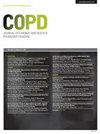A Diagnostic Nomogram for Predicting Hypercapnic Respiratory Failure in Patients with Acute Exacerbation of Chronic Obstructive Pulmonary Disease
IF 3.1
3区 医学
Q1 Medicine
International Journal of Chronic Obstructive Pulmonary Disease
Pub Date : 2024-05-18
DOI:10.2147/copd.s454558
引用次数: 0
Abstract
Purpose: To develop and validate a nomogram for assessing the risk of developing hypercapnic respiratory failure (HRF) in patients with acute exacerbation of chronic obstructive pulmonary disease (AECOPD).Patients and Methods: From January 2019 to August 2023, a total of 334 AECOPD patients were enrolled in this research. We employed the Least Absolute Shrinkage and Selection Operator (LASSO) regression and multivariate logistic regression to determine independent predictors and develop a nomogram. This nomogram was appraised by the area under the receiver operating characteristic curve (AUC), calibration curve, Hosmer–Lemeshow goodness-of-fit test (HL test), decision curve analysis (DCA), and clinical impact curve (CIC). The enhanced bootstrap method was used for internal validation.
Results: Sex, prognostic nutritional index (PNI), hematocrit (HCT), and activities of daily living (ADL) were independent predictors of HRF in AECOPD patients. The developed nomogram based on the above predictors showed good performance. The AUCs for the training, internal, and external validation cohorts were 0.841, 0.884, and 0.852, respectively. The calibration curves and HL test showed excellent concordance. The DCA and CIC showed excellent clinical usefulness. Finally, a dynamic nomogram was developed (https://a18895635453.shinyapps.io/dynnomapp/).
Conclusion: This nomogram based on sex, PNI, HCT, and ADL demonstrated high accuracy and clinical value in predicting HRF. It is a less expensive and more accessible approach to assess the risk of developing HRF in AECOPD patients, which is more suitable for primary hospitals, especially in developing countries with high COPD-related morbidity and mortality.
Keywords: acute exacerbation of chronic obstructive pulmonary disease, hypercapnic respiratory failure, nomogram, prediction model
预测慢性阻塞性肺病急性加重患者高碳酸血症呼吸衰竭的诊断提名图
目的:开发并验证用于评估慢性阻塞性肺疾病急性加重期(AECOPD)患者发生高碳酸血症呼吸衰竭(HRF)风险的提名图:自2019年1月至2023年8月,共有334名AECOPD患者参与了此次研究。我们采用最小绝对值缩减和选择操作器(LASSO)回归和多变量逻辑回归来确定独立预测因素,并制定了一个提名图。该提名图通过接收者操作特征曲线下面积(AUC)、校准曲线、Hosmer-Lemeshow 拟合优度检验(HL 检验)、决策曲线分析(DCA)和临床影响曲线(CIC)进行评估。内部验证采用了增强引导法:结果:性别、预后营养指数(PNI)、血细胞比容(HCT)和日常生活活动能力(ADL)是 AECOPD 患者 HRF 的独立预测因素。基于上述预测因子开发的提名图显示出良好的性能。训练队列、内部队列和外部验证队列的 AUC 分别为 0.841、0.884 和 0.852。校准曲线和 HL 测试显示出很好的一致性。DCA 和 CIC 显示出很好的临床实用性。最后,得出了一个动态提名图(https://a18895635453.shinyapps.io/dynnomapp/):该提名图基于性别、PNI、HCT 和 ADL,在预测 HRF 方面具有很高的准确性和临床价值。它是评估 AECOPD 患者发生 HRF 风险的一种成本较低、更易于使用的方法,更适合基层医院使用,尤其是在 COPD 相关发病率和死亡率较高的发展中国家。
本文章由计算机程序翻译,如有差异,请以英文原文为准。
求助全文
约1分钟内获得全文
求助全文
来源期刊

International Journal of Chronic Obstructive Pulmonary Disease
RESPIRATORY SYSTEM-
CiteScore
5.10
自引率
10.70%
发文量
372
审稿时长
16 weeks
期刊介绍:
An international, peer-reviewed journal of therapeutics and pharmacology focusing on concise rapid reporting of clinical studies and reviews in COPD. Special focus will be given to the pathophysiological processes underlying the disease, intervention programs, patient focused education, and self management protocols. This journal is directed at specialists and healthcare professionals
 求助内容:
求助内容: 应助结果提醒方式:
应助结果提醒方式:


